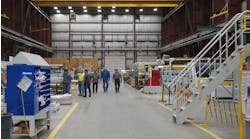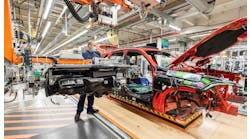Be Clear About What You Plan to Solve With Automation
Small and medium-sized manufacturers (SMMs) know they need to invest in automation, so they buy their first collaborative robot (cobot) after seeing a demonstration of its capabilities. They assume there is a place for the cobot somewhere in their operation. But if they haven’t considered all the related impacts on their people and processes, their chances of a successful automation implementation are diminished.
The most important aspect of your first automation project is to be clear about what problem you are trying to solve. Your first automation goal may be related to labor issues. Maybe you are struggling to find enough people to fill positions. In this case, a good starting point is to find an automation solution for the unfilled job no one wants to do. Alternatively, maybe it is a task to alleviate a process pain point or it is an inefficient aspect of your operation that is costing you money.
Once you have decided what to take on with your next automation project, these two approaches can help improve your chances for success:
-
Link the initiative to financial performance. Automation and Industry 4.0 provide the connectivity and access that can make your operations more data driven. Better data provides a window into your operations enabling you to realize the amount of money you are making or losing in real time.
-
Use a system mindset for adoption. With clear goals in mind, build a system around the technology. For example, while a cobot is great at replicating a repetitive motion, it needs to be programmed for each separate task you want it to perform. Think about providing your team with human-machine interface (HMI) training to introduce them to automation controls. This is especially important for high-mix, low-volume (HMLV) operations.
I’m with the Industry 4.0 team at the Michigan Manufacturing Technology Center (MMTC), part of the MEP National Network, and we offer a Technology Opportunity Assessment, including an Introduction to Collaborative Robots class. Your local MEP Center is ready and able to provide your company with similar training. Working with a trusted advisor who is not selling you equipment is a big help in assessing your needs, and creating a well-defined process that accounts for variables, implementation, and support. This article outlines how to get your first automation initiative started.
Have a Plan Before Getting a Quote
Some technology vendors and automation integrators will respond to your quote request with a “no quote” because the project does not meet their minimum revenue threshold. Perhaps the project is too risky, or, if you are provided with a quote, it may be a bigger investment than you are ready to make.
For example, consider whether you should start with hard automation (equipment) or soft automation (software for data collection and monitoring). Like many manufacturers, leveraging your manufacturing execution system (MES) will be the most productive immediate step to set you up for later success with hard automation. An MES links your production floor to your front office.
To help your decision-making process, start by making a process map of your operations to confirm what causes variations and issues. This will help determine what types of tools or automation may be in order. How do you know if a process can be handled by a collaborative robot or an industrial robot? Consider the following:
-
Cobots are designed for safe human interaction, generally operate at slower speeds, and have lower payload capabilities. Ideal cobot applications include:
-
Loading or moving lightweight boxes
-
Bin picking with a gripper
-
Tape dispensing and similar repetitive motions
-
Machine tending
-
Industrial robots typically offer higher speed and payload capacities, making them suitable for heavy-duty operations, such as:
-
A dangerous welding application
-
Painting that emits hazardous chemicals
-
Lifting heavy bags
Map Out Your Process: End-of-Line Palletizing
Once you determine what you want to accomplish with your automation project, it’s time to map out a process to scope the requirements. Let’s use end-of-the-line palletizing as our automation adoption example. It’s manual labor no one wants to do, so you are constantly filling those positions, and it should be an easy return on investment (ROI) to attain. A process might look like:
-
First, identify the requirements, such as picking a box from a conveyor, moving it above a pallet, and placing it on the pallet.
-
Then identify sources of variation, such as the box size and condition, conveyer position, pallet height and position, and the box arrangement on the pallet, etc.
-
Next, identify the solution that meets your needs, such as what type of cobot or robot to use, the type of arm tool, mounting, and machine integration requirements.
Let’s use mounting as an example. Robots need room to move, so you should avoid placing the base of a robotic arm directly above or below where it will be grabbing parts. There are also many ways to mount a robot; if you are mounting it on a cart for flexibility, you will need calibration fixtures or vision systems to ensure the robot is in the correct position and orientation for the task.
Start Slowly With a System Approach to Ensure Success and ROI
The best automation projects involve structuring a process that combines work tasks with multiple facets of your operation. It’s part of a big-picture transition that provides more paths forward and more impactful ROI. A “one-off” or isolated task has limited impact and is less likely to succeed.
It’s imperative to set yourself up for success, even if it means slowing down. For example, structuring one system or process for the first time can take several months. But if you do it right, the machine can often pay for itself in six months. Two factors come into play here:
-
Once the system and processes are ready, you often can get a robot running in a couple of days. When the MMTC helps manufacturers implement new automation, we’re usually hands off soon after if the preliminary system and process have already been done.
-
Automation vendors may not teach you how to build a system. Their goal is to get the application online as quickly as possible.
It’s important to incorporate any automation application into your system so your people on the floor will know how to respond if a machine is down or operating at less than peak efficiency. Many automation implementation projects struggle when no one pays attention to a dashboard that is “in the red,” (indicating ongoing issues), as they do not feel empowered to take actions.
That’s why you will want to factor your people and their skill sets into the automation implementation, operation, and support.
-
Who is going to build, install, and integrate the system? Are you going to do it in-house or hire an integrator?
-
Who teaches your operators? You can program motion, but can your robot talk to tooling, grippers, etc.? Do you need to bring these automation skills in-house?
-
You also should consider what you will need to support this automation long term, as you don’t want to be dependent on vendors.
Success Story: Cobot Does Machine Tending for Specialty Part
Now that we’ve covered key considerations for successful automation implementation, I’d like to share a real-world success story. Coventry Industries is a small company that focuses on fabricating, metal forming, custom machining, manufacturing feasibility, and engineering. They were looking for a way to machine an optic plate, which represented a growth opportunity but was not part of their core operations.
MMTC worked with Coventry to determine that they would benefit from implementing a cobot for machine tending. This would allow Coventry to do “lights-out” computer numerical control (CNC) manufacturing for their optic plates. MMTC developed a two-phase project to mentor Coventry and support the cobot implementation.
Three of Coventry’s CNC operators learned how to program the cobot and set it up to
run different parts, which created the capability for the cobot to run day and night. Within a few days, the cobot was put into production, which has led to a 300 percent increase in production for optic plates.
Your Local MEP Center Can Help You Select the Right Automation Project
Being clear about what you want to accomplish with your next automation project will increase your chances for a successful implementation. Tying it to financial performance and using a systems approach will help people rally around the learning required, implementation, and long-term impact. Your local MEP Center can help.
ABOUT THE AUTHOR
Robert Scipione
As the Manufacturing Services Manager at the Michigan Manufacturing Technology Center (MMTC), part of the MEP National Network, Scipione is dedicated to driving advancements in Michigan manufacturing, leading the effort to assist small to medium-sized manufacturers in applying quality management systems, Lean manufacturing and transactional tools and techniques, executive coaching, leadership skills, and Industry 4.0 manufacturing technology solutions.
Sponsored by:





